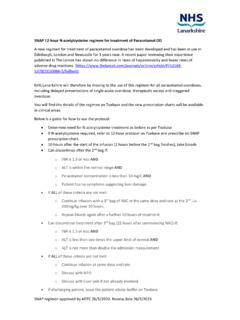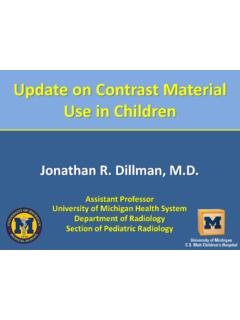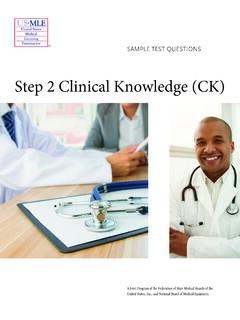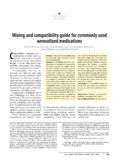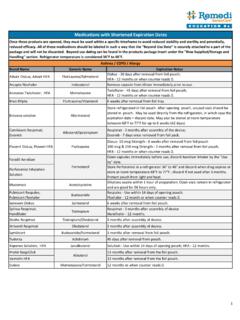Transcription of PRESCRIBING FOR THE PSA AND FINALS - Simply Revision
1 PRESCRIBING FOR THE PSA AND FINALSDR FRANCESCA BONORAWHAT WE WILL COVER HOW TO PREPARE FOR THE PSA EXAM HOW SCENARIOS APPLY TO PRESCRIBING FOR FINALSTHE PSA EXAM For full details of what could be on PSA blueprint for November 2017 PDF EXAMPLES OF ITEM STYLES SECTION 1 PRESCRIBING Decide on the most appropriate prescription (drug, dose, route and frequency), based on the clinical circumstances Write a safe, effective and legal prescription 8 questions worth 10 marks each Make sure you signthe prescriptions with your full surname (not initials) don t lose the easy marksHOW TO PREPARE Exam is time pressured, so LEARN TREATMENT ALGORITHMS: Acute conditions egacute asthma attack, acute heart failure Chronic depression, reflux oesophagitis Presenting pain Find these in the back of the Oxford handbookOXFORD HANDBOOK ALGORITHMS THIS BOOK IS GREATPASS THE PSA, 1E, FEB 2014, BY WILL BROWN BSC MBBS MRCP(UK) FHEA AND KEVIN W LOUDONTREATMENT ALGORTIHMS ANAPHYLAXIS ACUTE ASTHMAMAKE THESE FOR YOURSELF FOR ALL COMMONEST ACUTE AND CHRONIC MEDICAL CONDITIONSPASS THE PSA, 1E, FEB 2014, BY WILL BROWN BSC MBBS MRCP(UK) FHEA AND KEVIN W LOUDONHOW TO PREPARE If you can t remember use treatment summaries in the online BNF during the exam CTRL + F is your best friend!
2 BNF TREATMENT SUMMARIESCTRL + FPRESCRIBING CONTROLLED DRUGS WHICH IS CORRECT?MORPHINE SULPHATE 10mg oral tabletsTake one tablet, three times dailyPlease supply 28 (TWENTY-EIGHT) SULPHATE 10mg oral tabletsTake one tablet, three times supply 28 10mg(TEN MILLIGRAM) Andrew Smith01/10/87 Perrin Lecture Theatre29 Andrew Smith01/10/87 Perrin Lecture TheatrePRESCRIBING CONTROLLED DRUGS WHICH IS CORRECT?MORPHINE SULPHATE 10mg oral tabletsTake one tablet, three times dailyPlease supply 28 (TWENTY-EIGHT) SULPHATE 10mg oral tabletsTake one tablet, three times supply 28 10mg (TEN MILLIGRAM) s the total amount that you need to specify29 Andrew Smith01/10/87 Perrin Lecture Theatre29 Andrew Smith01/10/87 Perrin Lecture TheatrePRESCRIBING CONTROLLED DRUGS Include the nameand addressof the patient. State the nameand strengthof the drug State the doseand frequency TOTAL AMOUNT must be written in WORDS AND FIGURESWHAT DOSE SHOULD YOU PRESCRIBE?
3 WHAT DOSE SHOULD YOU PRESCRIBE?SECTION 2 PRESCRIPTION REVIEW Identify prescriptions (drugs, doses or routes) that are inappropriate, unsafe or ineffective from amongst the current list of prescribed medicines 8 items worth 4 marks eachPRESCRIPTION REVIEWFUROSEMIDEPREDNISOLONE11/1/17PO11/ 1/17PO40mg40mgPRESCRIPTION REVIEWFUROSEMIDEPREDNISOLONE11/1/17PO11/ 1/17PO40mg40mgSHOULD BE GIVEN IN MORNING WILL KEEP PATIENT AWAKE!SHOULD BE GIVEN IN MORNING WILL KEEP PATIENT AWAKE!SPOT THE MISTAKESSPOT THE MISTAKESINCORRECT DOSE SHOULD BE MICROGRAMSWRITE UNITS (NOT JUST U ) TECHNICALLY SHOULD BE PRESCRIBED ON THE INSULIN AREA OF THE CHART!WRITE MICROGRAMS IN FULLWHAT TYPE?FLUID CHART ERRORS11/1/17 Saline 1 litre KCl40mmol STAT Red Blood Cells 2 units -----------------4 hours 50% Dextrose 1 litre 12 hours CHART ERRORS11/1/17 Saline 1 litre KCl40mmol STAT Red Blood Cells 2 units -----------------4 hours 50% Dextrose 1 litre 12 hours amount of potassium must be given over at least 4 hours due to risk of arrhythmiasEach unit needs to be prescribed separatelyHas to be discarded 4 hours (from leaving the lab)50% Dextrose is irritant to veins.
4 It should only be given in small volumes (20% should preferably be used if trying to reverse hypoglycaemia)SECTION 3 PLANNING MANAGEMENT Deciding which treatment would be most appropriate to manage a particular clinical situation 8 items worth 2 marks each Choose most appropriate treatment from list of 5 COMMON ACUTE CONDITIONS KNOW THE TREATMENT ALGORITHMS FOR: STEMI NSTEMI ACUTE LEFT VENTRICULAR FAILURE TACHYCARDIA WITH PULSE ANAPHYLAXIS ACUTE ASTHMA EXACERBATION PNEUMONIA PE GI BLEED BACTERIAL MENINGITIS SEIZURE STATUS EPILEPTICUS STROKE HYPERGLYCEMIA DKA AND HHS AKI POISONING COMMON CHRONIC CONDITIONS KNOW THE TREATMENT ALGORITHMS FOR: HYPERTENSION CHRONIC HEART FAILURE STROKE PREVENTION STABLE ANGINA CHRONIC ASTHMA COPD DIABETES INSOMNIA CONSTIPATION DIARRHOEA PAINSECTION 4 PROVIDING INFORMATION Decide the most important piece of information that should be provided to patients to allow them to choose whether to take the medicine and to enhance its safety and effectiveness Six items worth 2 marksPROVIDING INFORMATION DRUGINFORMATIONRAMIPRILSTOP IN PREGNANCY TERATOGENICGLICLAZIDE EAT REGULARLY.
5 DON T SKIP MEALS HYPO RISKMETHOTREXATEREGULARFBC NEUTROPENIA RISKWARFARIN MONITOR INR -BLEEDINGLONG TERM STEROIDSTAKEBISPHOSPHONATE OSTEOPEROSIS RISK DON T STOP SUDDENLYSSRICONTACT DOCTOR IF THOUGHT OF SELF HARMINSULINDOSE MAY NEED TO BE INCREASED IF UNWELLBISPHOSPHONATETAKEWITH FULL GLASS OF WATER AND REMAIN UPRIGHT FOR 1 HOURSECTION 5 CALCULATION SKILLS Making an accurate drug dosage calculation based on numerical information Recording answer accurately with appropriate units of measurement 8 items worth 2 marksMAKE SURE YOU PRACTICE Correct number of tablets to achieve a required dose Making necessary dose adjustments based on weight or body surface area Diluting a drug for administration in an infusion pumpDRUG RATIOS1% means 1g in 100ml or 10mg in 1ml for weight/volume (w/v) calculations 1g in 100g for weight/weight calculations ADRENALINE RATIOS ANAPHYLAXIS = of 1 in 1,000 IM Remember 1 in 1,000 means: 1g in 1000 ml or 1000mg in 1000ml or 1ml in 1mg Therefore = CARDIAC ARREST 1mg = 10ml of 1 in 10,000IV Remember 1 in 10,000 means: 1g in 10,000 ml or 1,000mg in 10,000ml or 1mg in 10ml Dosage CalculationsAlways convert to the same units and then:D (What you want) x V (volume it is in) = DoseH (What you ve got)Try some practice questions: 6 ADVERSE DRUG REACTIONS Likely adverse reactions to specific drugs, potentially dangerous interactions, managing adverse effects of a drug 8 items worth 2 marks eachADVERSE DRUG REACTIONS THE CTRL + F SECTION Adverse effects caused by commonly prescribed drugs such as calcium channel blockers, beta2-agonists, non-steroidal anti-inflammatory drugs, aminoglycoside antibiotics, etc.
6 Most likely drug to have caused adverse renal impairment, hepatic dysfunction, hypokalaemia, urinary retention, etc. Potential interactions between medicines warfarin-statins, NSAIDs-ACE inhibitors How to treat an adverse drug reaction acute anaphylaxis, excessive anticoagulation, drug-induced hypoglycaemia, diuretic-induced dehydration etc. SPOT THE POTENTIAL ADVERSE EFFECTSPOT THE POTENTIAL ADVERSE EFFECTPOTASSIUM BOTH DRUGS CAN CAUSE HYPERKALAEMIASPOT THE POTENTIAL ADVERSE EFFECTPOTASSIUM BOTH DRUGS CAN CAUSE HYPERKALAEMIASome drugs causing HYPERKALAEMIA ACE Inhibitors Angiotensin Receptor Blockers (ARB) Beta Blockers Digoxin Heparin NSAIDs Spironolactone Transfusions of RBC TrimethoprimWHAT IS THIS PATIENT AT RISK OF ?WHAT IS THIS PATIENT AT RISK OF ?PHENYTOIN TOXICITYE nzyme inhibitorEnzyme inducer(but relatively less so)ENZYME INHIBITORS AND INDUCERS INDUCERS INHIBITORSI ncrease enzymeactivityReduce drug concentration Reduce enzymeactivityIncrease drug concentration PC BRASP henytoin Carbamazepine BarbituatesRifampicinAlcohol (chronic excess)SulphonylureasAODEVICESA llopurinol Omeprazole Disulfiram ErythromycinValproateIsoniazid Ciprofloxacin Ethanol (acute itntoxication)SulphonamidesWHAT IS THIS PATIENT AT RISK OF ?
7 OMEPRAZOLEPAROXETINE11/1/17PO11/1/17PO20 mg40mgWHAT IS THIS PATIENT AT RISK OF ?OMEPRAZOLEPAROXETINE11/1/17PO11/1/17PO2 0mg40mgDrugs commonly causing HYPONATRAEMIA Thiazide diuretics Amiloride Carbamazepine Sulphonylureas(but not Gliclazide) Proton pump inhibitors Antidepressants, particularly SSRIs ACE inhibitors and ARBs Opiates NEPHROTOXIC & HEPATOTOXIC DRUGSNEPHROTOXICHEPATOTOXICACE InhibitorsAminoglycosidesNSAIDsMethotrex ateAmiodaroneIsoniazidCo-amoxiclavNSAIDs StatinsAnti-fungalsAnti-retroviralsPENIC ILLINALLERGYAVOIDCAUTIONSAFEFLUCLOXACILL INTAZOCINCO-AMOXICLAVCEFTRIAXONEMEROPENE MAMIKACINMETRONIDAZOLEERYTHROMYCINRIFAMP ACINPENICILLINALLERGYALLERGIC REACTION MANAGEMENTA patient recently given Tazocindespite a Type 1 Penicillin allergy develops shortness of breath, stridor and a widespread urticarial 3 appropriate treatments:A) Chlorphenamine4mg, POB) Adrenaline 10ml of 1:10000, IVC) Adrenaline 10ml of 1:10000, IMD) Adrenaline of 1:1000, IVE) Adrenaline of 1.
8 1000, IMF) Hydrocortisone 200mg, IVG) Chlorphenamine10mg, IVALLERGIC REACTION MANAGEMENTA patient recently given Tazocindespite a Type 1 Penicillin allergy develops shortness of breath, stridor and a widespread urticarial 3 appropriate treatments:A) Chlorphenamine4mg, PO only after resuscitationB) Adrenaline 10ml of 1:10000, IV cardiac arrest, 1mgC) Adrenaline 10ml of 1:10000, IM never usedD) Adrenaline of 1:1000, IV never usedE) Adrenaline of 1:1000, IM ) Hydrocortisone 200mg, IVG) Chlorphenamine10mg, IVSECTION 7 -DRUG MONITORING How to monitor the beneficial and harmful effects of medicines. 8 items worth 2 marksDRUG LEVEL MONITORING -EXAMPLESDrugHalf-lifeTimingToxicLevel*M ajor ToxicEffectsGentamicin2hTroughAfter 2-3 doses>2mcg/mlNephrotoxity,irreversible ototoxicityPhenytoin20-40hTroughAfter 2-3 daysTotal >20mcg/mlFree>2mcg/mlNystagmus, diplopia,ataxia, confusion, hyperglycaemiaAminophylline4-16hrN/A4-6h rsafter starting IV infusion>20mcg/mlArrhythmias, convulsions, hypotensionTheophyllineTrough5 daysDigoxin24-36hTrough1 week>2ng/mlArrhythmias, visual disturbance,anorexiaSome detail on specific drugs: DRUG MONITORINGDRUGMONITORWARFARININRLEVOTHYR OXINETFT (CHANGE DOSE EVERY 4 WEEKS)ACE INHIBITORS / DIURETICSU&EsCLOZAPINEFBCORALCONTRACEPTI ONBLOOD PRESSUREGENTAMICIN DOSINGH artford nomogram: guides when to give patient next dose, based on blood concentration and the time the measurement was taken if concentration is 8mg/ml, 8h after start of infusion what is correct dosing interval?
9 GENTAMICIN DOSINGH artford nomogram: guides when to give patient next dose, based on blood concentration and the time the measurement was taken Answer: 36hSECTION 8 DATA INTERPRETATION Make an appropriate change to a prescription based on results of investigations 6 items worth 2 marksPARACETAMOL OVERDOSEA ctivated charcoal: consider if >150mg/kg has been taken within a 1 hour (NAC): Single overdose check level at 4h and use the nomogram (use nomogram when OD has been taken between 4-8h ago) If plasma concentration levels are above the treatment line then you need to treat Staggered overdose (>1h) cannot accurately calculate levels so treat PARACETAMOL Patient takes 10 paracetamol tablets at test taken at concentration OVERDOSEDON T TREAT PRESCRIBING SCENARIOS FINALS All the same scenarios in different formats OSCES Prescribe warfarin Prescribe an IM injection egvitamin B12 Spot the prescription errors Write fluid prescription and calculate drip rates Presenting a history and giving treatment recommendations eghypertension WRITTEN PAPER Know your treatment algorithms for acute and chronic conditions Data interpretation questions remember side effects of drugs and how they can affect blood results GOOD
